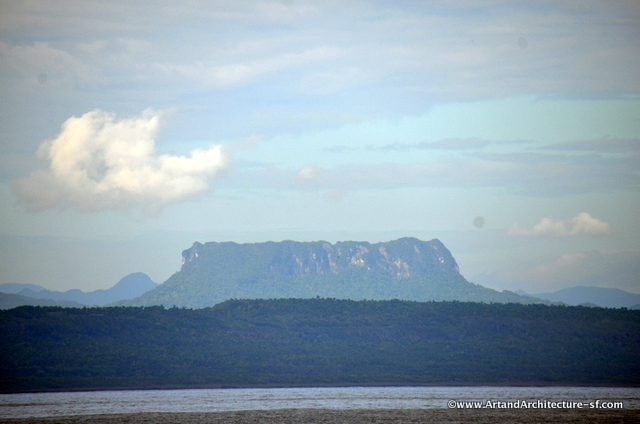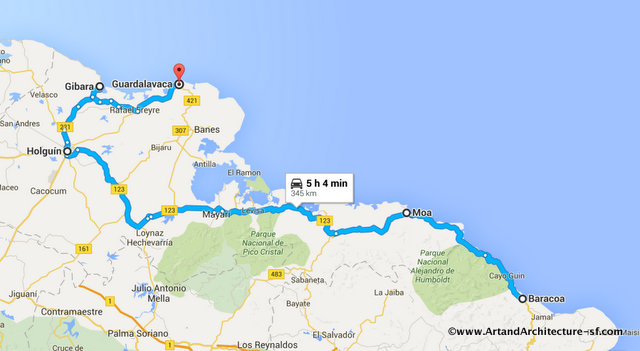October 2015
 If one heads North of Baracoa you get to Playa Maguana. This absolutely stunning white sand beach has a small government run hotel (Villa Maguana) with its own small private beach and fairly decent restaurant and bar. I have stayed in many government hotels in Cuba, do not let this photo fool you, this gem is very, very unique.
If one heads North of Baracoa you get to Playa Maguana. This absolutely stunning white sand beach has a small government run hotel (Villa Maguana) with its own small private beach and fairly decent restaurant and bar. I have stayed in many government hotels in Cuba, do not let this photo fool you, this gem is very, very unique.
 It is twelve miles from Baracoa to Manguana and the entire road is like this. It makes for a very long slog.
It is twelve miles from Baracoa to Manguana and the entire road is like this. It makes for a very long slog.
If you travel this way you will go along the foot of El Yunque. El Yunque is a 1,885 foot limestone formation covered with vegetation and was a sacred site for the Taino Indians. Named by the Spanish, (the anvil) its shape is recognizable for miles.
We continue on this rather bad road towards the town of Holquin. Along the way one passes the Parque Nacional de Humboldt. This UNESCO World Heritage site was discovered by German explorer, Alexander von Humboldt.
Many miles after leaving Managuan we spotted a family building this structure along the completely desolate, and still horrible, road. We hopped out to ask what they were doing and were told it is going to be a cafeteria. To me this is one of the exciting signs that capitalism is coming to Cuba and the Cubans are looking forward to a better life. We asked about the road, and they hoped, as much as we did that it would be improved one day.
You leave the State of Guantanamo and enter the State of Holquin. The bad road stops somewhere along the road, but of the 45 miles from Baracoa to Moa, not much is paved.
The Moa area is known for its nickel, cobalt and chromium mining. In fact this area has the largest deposit of nickel in the world, estimated at 800 million tons. Sadly, the mining activities have devastated the area. There has been deforestation of well over 3000 acres, there is ground, water and air pollution, slope instability and severe changes in the water table. The bay and the aquifers are polluted with both the presence of heavy metals and sulphate.

A train/bus on the road to Gibara. The transportation in Cuba is so bad that necessity is the mother of invention. Here a bus is outfitted to run on the train tracks.
Our first stop on the coast was the very small town of Gibara on the border of the State of Holquin with the State of Las Tunas. Gibara is centered around its main square with the Iglesia de San Fulgencia, built in 1854, at its heart. There is a sweet little Natural History Museum preported to have the best butterfly collection in Cuba. The town, also called “Villa Blanca” (white village) or “Village of the Crabs” is rich in colonial architecture. Isadora Duncan danced at the local theater, said to be the best in the country at the time, sadly the date of her performance is not known.
This replica of the Statue of Liberty was erected in 1915 with contributions by locals. It was the idea of Enriqueta de la Torre y Delgado. A veteran of the War of Independence against the Spanish Mercedes Sirvén Pérez-Puelles unveiled the monument and Aurora Pérez Desdín, a local Gibara woman was the model for the face of the statue.
 The Hotel Encanto Arsenita is just of the square and dates to the beginning of the 20th century. It is named for the original owner, Maria Arsenia Martinez, a teacher, better known as Arsenita.
The Hotel Encanto Arsenita is just of the square and dates to the beginning of the 20th century. It is named for the original owner, Maria Arsenia Martinez, a teacher, better known as Arsenita.
Continuing along the road towards Guardalavaca, one only catches glimpses of the coast.
 The most beautiful beaches along this coast are owned by the government. They stretch from Bahia de Naranjo to Guardalavaca. The ridiculous amount of hotels form a wall between the road and the beach, making the area inaccessible to anyone not paying to stay in a hotel.
The most beautiful beaches along this coast are owned by the government. They stretch from Bahia de Naranjo to Guardalavaca. The ridiculous amount of hotels form a wall between the road and the beach, making the area inaccessible to anyone not paying to stay in a hotel.
The price of these hotels (from $120 – 300/night) include your meals, watered down drinks and entertainment that leaves a lot to be desired. The rooms are adequate and the food barely palatable, however, this is not Cuba, it is a resort with not a hint of the country you are in.
At one time Cubans were not allowed to stay in these hotels, however, it is now permissible, but the largest amount of visitors are Canadians and Germans who have been coming for years.
There is a delightful little hotel in Don Lino ($60/night) for those on a budget and who want the Cuban beach without the Spring Break wrist band, experience. Playa Blanco also has a wonderful beach and a funky restaurant, however, it has no lodgings.
Three miles south of Guardalavaca is Chorro de Maíta. This is the largest native Indian necropolis in Cuba. The state of Holquin has yielded one-third of all of Cuba’s archeological finds.
The bones have been tested and show that they belong to people that lived somewhere between 1490 and 1540. The area covers about one-half an acre with 56 of the discovered 108 graves visible.
The site is now recognized as a village of indios encomendados (indigenous individuals serving the Spanish colonizers under a regime of forced labor).











